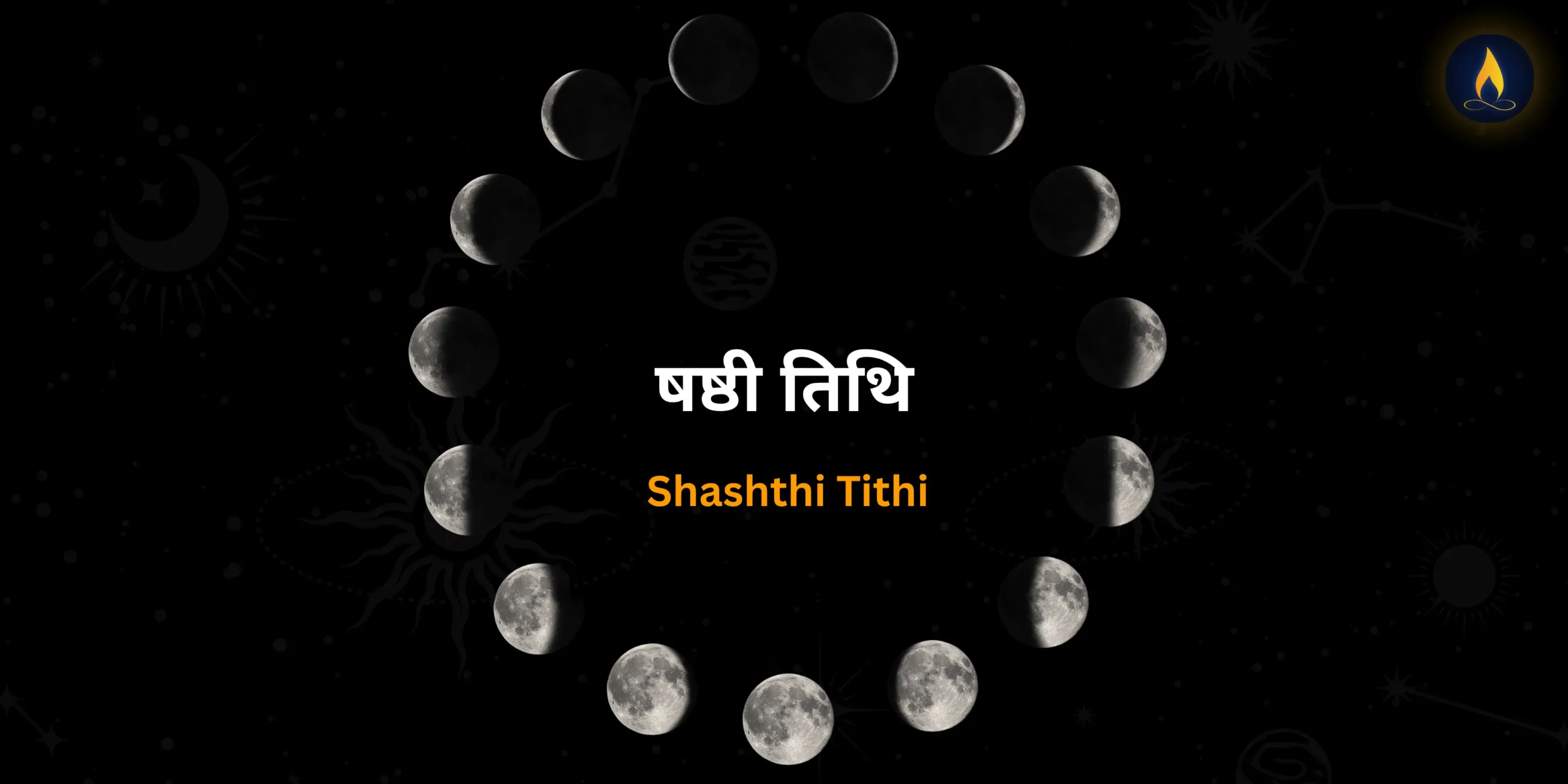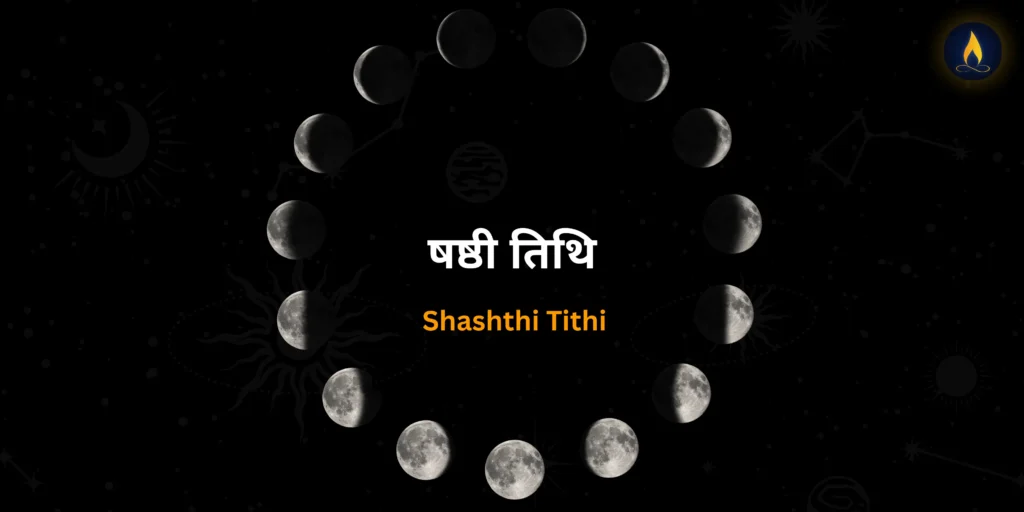Blog Contents
ToggleShashthi Tithi (षष्ठी) is the sixth lunar day in our Vedic calendar. At first, it might look like just another tithi, but in reality, Shashthi holds deep spiritual meaning in Hindu traditions, Vedic astrology, and family rituals.
Shashthi comes after Panchami and carries the energy of both protection and new beginnings. It is especially connected to children, creativity, and maternal blessings. Let’s explore what this tithi means and how to observe it properly.
What is Shashthi in Vedic Astrology?
- Tithi Number: 6th day in the lunar cycle
- Sun–Moon Angle: 60° to 72° separation
- Paksha: Appears twice every month – in Shukla and Krishna Paksha
- Meaning: “षष्ठी” means “sixth” – shows initiation, first step of growth
- Symbol: A seed sprouting – new potential, future protection
- Energy: Nurturing, start of real formation, maternal protection
This tithi is very suitable for soft beginnings – like baby-related rituals, health practices, family puja, and connection with nature.
🌔 Shashthi in Shukla Paksha – Rising Energy
In Shukla Paksha, the Moon is growing, and so is your energy. This version of षष्ठी supports healing, family bonding, and creative ideas.
Dos:
- Do puja for children’s health
- Start wellness or spiritual routines
- Visit temples or offer water to sacred plants
- Perform rituals to bless your home or family
Don’ts:
- Avoid harsh food or speech
- No large gatherings or flashy events
👉 This is a perfect day to initiate your intentions and give them quiet support.
🌘 Shashthi in Krishna Paksha – Gentle Withdrawal
In the Krishna Paksha, Shashthi becomes a more reflective phase. It’s less about outside action and more about emotional healing, clearing, and ancestral balance.
Dos:
- Perform षष्ठी Devi Vrat
- Clean your living space or sacred corner
- Offer fruit, milk, or simple daan (donation) to a mother or child
Don’ts:
- No heavy travel, spending, or emotional drama
- Avoid ego fights or eating meat/heavy foods
🌑 Krishna Shashthi is ideal for inner prayers, small fasts, and maternal connection.
Sanskrit Shloka & Beeja Mantra
Traditional Shloka (offered to Goddess Shashthi):
“षष्ठी तिथे नमो नमः, बालगोप्त्री सुरार्चिता।
रोगशोकविनाशाय, देवी त्वं शरणं मम॥”
Beeja Mantra for Shashthi Devi:
“ॐ श्रां श्रीं श्रौं सः शष्ठ्यै नमः”
🌸 Chant 108 times in the morning for mental clarity, child blessing, and peaceful heart.
Astrological Effects of Shashthi
Shashthi is ruled by creative and maternal forces. It’s not overly active, but gentle and initiating.
🌿 Positive Effects When Strong
- Supports new learning and spiritual growth
- Auspicious when combined with Rohini, Swati, or Hasta Nakshatra
- Brings peaceful home, child-related blessings, or creative flow
🌑 Negative Effects If Weak or Afflicted
- May cause child-related worries or family disconnection
- Malefic planets (like Mars or Ketu) on षष्ठी may disturb emotions
Remedies: - Fast on this day, chant the mantra, and offer milk to cows or poor children
Presiding Deity of Shashthi
षष्ठी is protected by Shashthi Devi, the guardian goddess of children, birth, and feminine healing.
- In Sukla Paksha, she blesses creation and health
- In Krishna Paksha, she guides family healing and emotional balance
🪔 Offerings:
- Red/yellow flowers, fruits, jaggery, and milk
- Light a diya and chant her name with soft heart
Since tithis are influenced by the Moon, explore our blog on the Moon and its significance in Vedic astrology here!
🧘♂️ Spiritual Significance and Ideal Practices
षष्ठी helps you build inner protection. You don’t need grand rituals—just a sincere heart.
Good Practices on This Day:
- Simple japa, small fasting (milk, fruits), or temple visit
- Offer food to a mother or child
- Light ghee lamp in your kitchen or bedroom corner
- Take a walk in nature, observe silence, or offer tulsi water
🧘 Especially supportive for yoga, bhakti, or mantra sadhana.
🎉 Festivals and Events Celebrated on Shashthi
षष्ठी is quiet yet spiritually powerful. It hosts unique festivals connected to family and protection:
🌸 Jamai Shashthi
A Bengali tradition for blessing sons-in-law
→ Mothers-in-law invite them for food and rituals
→ Connects to षष्ठी Devi who protects household blessings
🌸 Skanda Shashthi
Dedicated to Lord Kartikeya
→ Worshipped for protection, war victory, and purification
→ Special pujas held in temples for valor and dharma
🌸 Shashthi Devi Vrat
Observed monthly by mothers for child’s health and mental peace
→ Fasting and diya lighting done in quiet reflection
→ Strengthens maternal devotion and divine blessings
🌸 Surya Shashthi
A major sun-worship festival in Nepal, Bihar & North India
→ Devotees offer arghya to the setting and rising sun
→ Brings fertility, health, and prosperity in family life
🌼 In Nepal, it’s common in Newari, Maithili, and Madhesi communities to observe षष्ठी for household rituals.
Auspicious & Inauspicious Activities
Best Activities on This Tithi
- Do mantra japa and health prayers
- Start home-based rituals or healing work
- Begin simple planning (education, family care)
- Offer daan to mothers, children, or cows
Avoid These
- Avoid travel, heavy buying/selling, or wedding-related work
- Don’t get into arguments or over-eating
📆 Muhurta & Panchang Tips
- Sukla षष्ठी: Auspicious in the morning or afternoon hours
- Krishna षष्ठी: Best in quiet times – post-lunch or before sunset
- Good combos: षष्ठी with Revati, Swati, or Rohini Nakshatra
📲 Check Nepali Panchang apps or websites for correct Muhurta.
📌 Key Takeaways
- Shashthi Tithi means “sixth lunar day” and appears twice every month
- Sukla version: soft beginnings, child health, family rituals
- Krishna version: inner cleansing, motherly connection, emotional release
- Presided by षष्ठी Devi, a nurturing and protective goddess
- Suitable for mantra, fasting, family daan, and temple visits
- Avoid harsh talks, bold plans, or emotional clashes on this day
FAQs
How to observe Shashthi fast every month?
Wake up early and take a bath. Eat light if needed—fruits or milk only. Chant the beeja mantra “ॐ श्रां श्रीं श्रौं सः शष्ठ्यै नमः” and offer water, yellow flowers, or sweets to Shashthi Devi. Keep your mind calm. Break the fast in the evening after lighting a diya and offering prayer.
Which God is Shashthi?
षष्ठी Devi is the goddess of this tithi. She protects children, blesses mothers, and ensures safe beginnings. She’s often worshipped as a golden mother riding a black cat.
How to perform Shashthi pooja at home?
Clean your home and prayer space. Light a diya (ghee or mustard oil), offer fruits, jaggery, and red/yellow flowers. Chant her name and, if possible, read षष्ठी Vrat Katha. You can place offerings near a sacred plant or tree (like peepal or banyan).
What can be eaten during Shashthi fasting?
Take only sattvic food: milk, fruits, simple khichdi, or boiled vegetables. Avoid heavy masala, non-veg, garlic, or onion. Many women fast fully till evening, while others take light food once.









